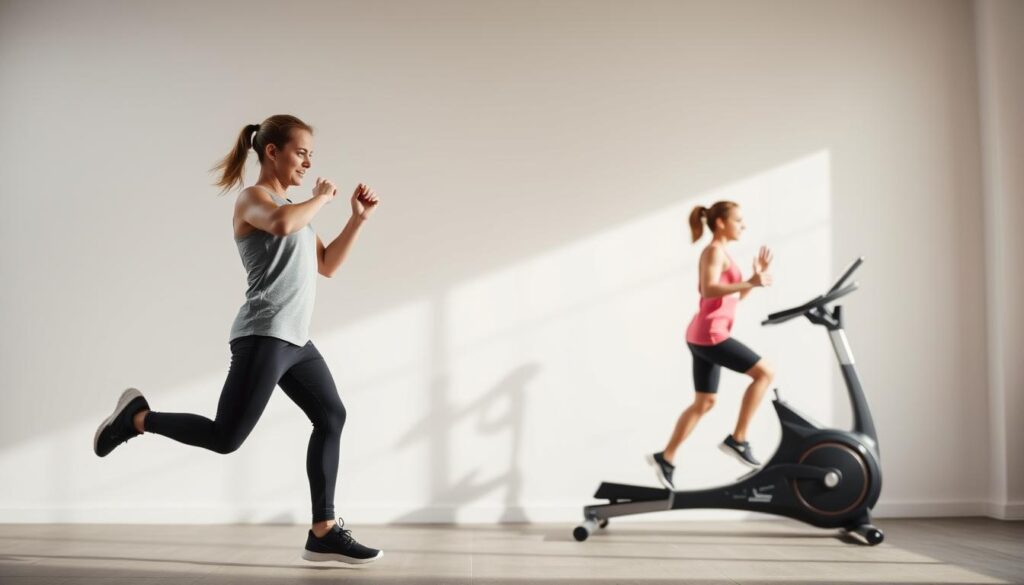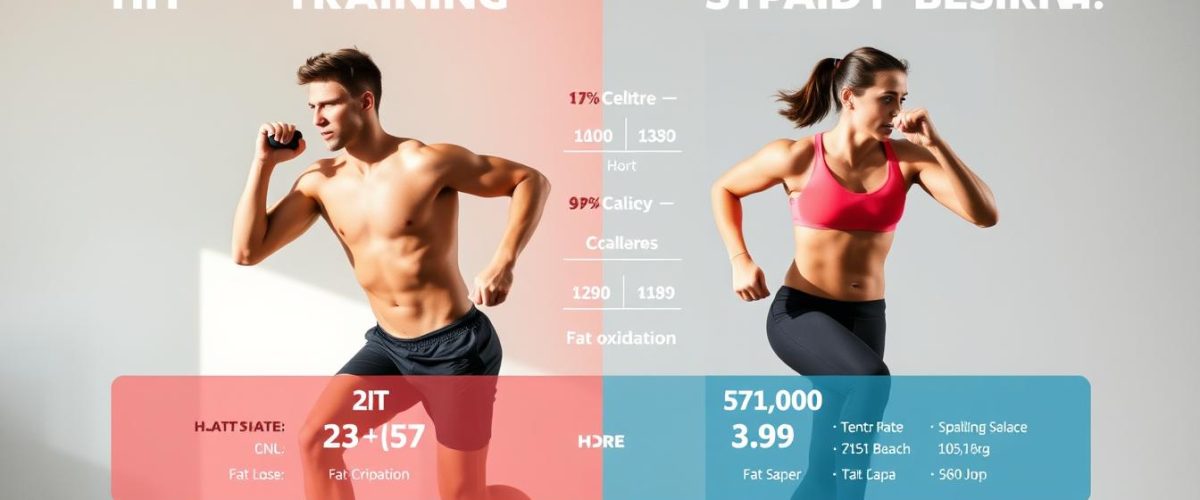Are you stuck deciding between High-Intensity Interval Training (HIIT) and steady-state cardio for losing fat? You’re not alone. Both methods have their fans and advantages.
Ashlyn Muraco, an exercise expert at The Ohio State University Wexner Medical Center, says, “HIIT is great for improving performance, burning fat, or building strength. But steady-state cardio is becoming popular because it’s easier, helps with recovery, boosts mental health, and is a long-term solution.“
This article will explore the differences between HIIT and steady-state cardio for fat loss. You’ll learn about their unique benefits and drawbacks. This will help you pick the best cardio workout for you, now you going to know which better hiit vs steady state.
Understanding HIIT: What You Need to Know
High-Intensity Interval Training (HIIT) is simple yet powerful. It involves short, intense exercise bursts followed by brief rest periods. This method is known for its calorie-burning efficiency and cardiovascular health benefits.
Definition of High-Intensity Interval Training
HIIT combines short, intense exercise with rest or low-intensity periods. This cycle lasts from 15 to 45 minutes. Its flexibility makes it suitable for all fitness levels.
HIIT workouts can include various exercises, making it versatile. It can be adjusted for both beginners and advanced athletes.
Benefits of HIIT Workouts
hiit vs steady state
One major benefit of HIIT workouts is their calorie-burning efficiency. You burn calories during and after the workout due to excess post-exercise oxygen consumption (EPOC).
HIIT also boosts cardiovascular health, increases metabolic rate, and enhances muscular endurance. It’s a great choice for those with busy schedules because it’s time-efficient.
Popular HIIT Exercises
Effective HIIT exercises include sprints, burpees, jump squats, and mountain climbers. These exercises quickly increase your heart rate and work multiple muscles.
You can also use kettlebells, dumbbells, or resistance bands to add variety. The goal is to choose exercises you enjoy and that challenge you.
Exploring Steady State Cardio
hiit vs steady state
Steady state cardio means doing cardio exercises at a steady pace for a long time. It’s about keeping the intensity the same, like when you jog, cycle, or swim.
Definition of Steady State Cardio
Experts say steady state cardio is about keeping a steady effort for a long time. For example, Ashlyn Muraco explains it as “a type of exercise done at a steady pace for a long time.” This steady pace is what makes it good for losing fat.
Advantages of Steady State Training
hiit vs steady state
Steady state training has many benefits, especially for losing fat and improving heart health. Some key advantages are:
- Improved Cardiovascular Health: It makes your heart work better.
- Enhanced Fat Burning: It helps your body burn fat better.
- Increased Endurance: It makes you more energetic for daily tasks.
To show the benefits and activities of steady state cardio, let’s look at a comparison table:
| Activity | Intensity Level | Duration |
|---|---|---|
| Jogging | Moderate | 30-60 minutes |
| Cycling | Moderate | 30-90 minutes |
| Swimming | Moderate | 20-60 minutes |
Common Steady State Activities
Popular steady state activities include jogging, cycling, and swimming. These are loved because they’re easy to keep up with.
Adding steady state cardio to your routine can really help your heart and fat loss. It’s important to pick activities you like so you’ll keep doing them.
Comparing Intensity Levels: HIIT vs Steady State
hiit vs steady state
When it comes to losing fat, knowing the intensity of workouts is key. You should understand how High-Intensity Interval Training (HIIT) and Steady State Cardio compare. This helps you choose the best exercise routine for you.
The Science of Intensity in Workouts
Workout intensity is measured as a percentage of your maximum heart rate. HIIT includes short, intense exercises at 80-95% of your max heart rate, with brief rests in between. It’s great for your heart and muscles.
Steady State Cardio, however, is done at a lower intensity, around 50-70% of your max heart rate. It’s done for longer periods. It’s good for your heart and endurance.
How Intensity Affects Fat Loss
hiit vs steady state
Workout intensity affects fat loss. HIIT burns more calories in less time. It also raises your resting metabolic rate (RMR) for hours after exercise. This means you keep burning calories even after your workout.
Steady State Cardio burns calories during exercise but may not boost your metabolism as much as HIIT. Still, it’s great for beginners or those who prefer longer, less intense workouts.
Energy Expenditure in Both Methods
Energy expenditure is key when comparing HIIT and Steady State Cardio. Studies show HIIT leads to higher excess post-exercise oxygen consumption (EPOC). This means your body burns more calories after exercise. But, Steady State Cardio burns calories mainly during the workout.
Knowing these differences helps you create a workout plan that suits your goals and preferences. This way, you can maximize your fat loss.
Time Efficiency: HIIT vs Steady State
Time is crucial when it comes to exercise. Knowing how HIIT and steady-state cardio compare in terms of time can be a big help. It’s not just about how well a workout works, but also how it fits into your busy life.
Duration of Workouts
HIIT workouts are known for being short and sweet. They last from 15-30 minutes, packed with intense exercise. In contrast, steady-state cardio can take up to an hour. If you’re always on the go, HIIT might be the better choice.

hiit vs steady state
Impact on Daily Schedules
HIIT’s short length is a big plus for busy people. It lets you squeeze in a workout even on the most hectic days. Steady-state cardio, though longer, can be done at any time that works for you.
Maximizing Results in Less Time
HIIT is great for burning fat quickly. Its intense nature means you can burn a lot of calories in a short time. Plus, your body keeps burning calories after you’re done working out. Steady-state cardio burns calories too, but it’s all about being consistent to see results.
Tips for Maximizing Time Efficiency:
- Combine HIIT with strength training to boost overall calorie burn.
- Schedule your workouts during your most energetic times of the day.
- Be consistent with your chosen workout routine to see sustained results.
Fat Burn: Which Method is More Effective?
hiit vs steady state
HIIT and steady-state cardio are both popular for losing fat. But, which one works better? Let’s dive into the science behind them.
Understanding the Fat-Burning Zone
The fat-burning zone is when your body uses fat as its main fuel. It’s often linked to low-intensity workouts, like steady-state cardio. You can still talk while doing it. But, does it really mean you lose more fat?
Key factors influencing the fat-burning zone include:
- Intensity of the workout
- Duration of the exercise
- Individual’s fitness level
Research Findings on Fat Loss
Studies show both HIIT and steady-state cardio can help with fat loss. But, it depends on what you want and like. HIIT burns a lot of calories, both during and after working out.
HIIT burns more calories in less time. Steady-state cardio is better for longer workouts. The best method is one you enjoy and can keep up with.
Individual Variability in Results
Results for fat loss with HIIT and steady-state cardio vary a lot. Your genes, diet, and fitness level play big roles. They affect how well you lose fat with either method.
Consider the following when choosing a method:
- Your personal preferences regarding exercise intensity and duration
- Your current fitness level and how it impacts your ability to perform HIIT or steady-state cardio
- Your dietary habits and how they complement your chosen exercise method
Recovery: HIIT vs Steady State
hiit vs steady state
Recovery is key to your fitness success, whether you’re into HIIT or steady-state exercises. It helps your body adjust to the challenges you face.
HIIT is intense, which means your body needs more time to recover. Steady-state cardio is less demanding, so it requires less recovery time.
Recovery Time Considerations
Choosing between HIIT and steady-state cardio depends on recovery time. HIIT needs longer recovery because it’s so intense. It causes more muscle damage and stress. Steady-state cardio, being less intense, requires less recovery.
Here are some recovery time points to consider:
- Intensity Level: More intense workouts like HIIT need longer to recover.
- Duration of Workout: Longer workouts, of any type, often need more recovery.
- Individual Variability: Recovery times vary greatly based on fitness, age, and health.
Muscle Recovery and Adaptation
Muscle recovery is crucial for getting better at workouts. Good recovery lets your muscles repair and grow, helping you improve.
HIIT and steady-state cardio affect your body differently. HIIT makes your body stronger and more resilient. Steady-state cardio improves heart health but causes less muscle damage.

hiit vs steady state
How Each Affects Long-Term Training
The long-term effects of HIIT and steady-state cardio depend on recovery. Not enough recovery can lead to overtraining. This can hurt your performance, increase injury risk, and slow down fat loss.
To get the most from your workouts, balance them with enough recovery. This might include:
- Adjusting workout intensity and frequency based on recovery.
- Adding rest or active recovery days to your routine.
- Making sure you get enough sleep and nutrition for recovery.
Personal Preference: Choosing Your Workout Style
hiit vs steady state
Choosing between HIIT and steady-state cardio depends on what you like. The best workout is one you enjoy and can keep up with over time.
Many things affect your choice. These include your fitness goals, how fit you are now, and what you enjoy doing.
Factors Influencing Your Choice
What you enjoy and your lifestyle can guide your choice. If you like variety, HIIT might be better. It offers a mix of activities.
Steady-state cardio is good if you like a calm workout. Think about your schedule too. HIIT is quick, which is great if you’re busy.
Enjoyment and Sustainability
hiit vs steady state
Enjoying your workouts is key to success. If you like it, you’ll keep doing it. It’s also important to keep it interesting to avoid getting tired of it.
“Exercise is a celebration of what your body can do, not a punishment for what you ate.” – Unknown
It’s important to find a balance. Some people love the excitement of HIIT. Others prefer the steady pace of steady-state cardio.
Finding What Works for You
Try both HIIT and steady-state cardio to see what you like. Mixing them up can also keep your workouts fresh and exciting.
| Workout Style | Enjoyment Factor | Sustainability |
|---|---|---|
| HIIT | High variety, dynamic | Can be challenging to sustain long-term due to high intensity |
| Steady State | Relaxed, consistent pace | Easier to sustain long-term due to lower intensity |
The best workout is one that fits your life and keeps you motivated. It should match your preferences and goals.
The Role of Nutrition in Fat Loss
hiit vs steady state
Nutrition is key to losing fat, whether you do HIIT or steady-state cardio. Eating well helps both methods work better together.
Diet’s Impact on Exercise Methods
A good diet fuels your workouts and helps you recover. For HIIT and steady-state cardio, eat lots of proteins, complex carbs, and healthy fats.
Optimizing Nutrient Timing
When you eat matters a lot for losing fat. Eating the right foods at the right times boosts your metabolism and helps muscles recover. For example, eating protein after working out helps fix muscles.
Debunking Dietary Myths
Some diet myths can slow you down. Cutting calories too much can cause muscle loss and slow down your metabolism. Aim for a balanced diet that supports your exercise and health goals.
Combining a balanced diet with your exercise choice leads to lasting fat loss and better health.


